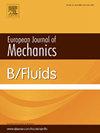Parametric study of traveling wave motion in energy absorption mode
IF 2.5
3区 工程技术
Q2 MECHANICS
引用次数: 0
Abstract
There are two modes of traveling wave motion, traveling wave propulsion and traveling wave energy absorption. In this paper, a two-dimensional flexible traveling wave plate is taken as the research object. The characteristic length and characteristic parameter of traveling wave motion are determined by numerical simulation, and the parametric study of the traveling wave motion in energy absorption mode is conducted. The effects of dimensionless amplitude and dimensionless wave velocity on the energy absorption characteristics of flexible traveling wave plate are analyzed, and the mechanism of traveling wave energy absorption is revealed. The results show that the larger the dimensionless amplitude is, the stronger the work capacity of the traveling wave plate becomes, while the absolute amplitude or absolute wavelength has little effect on the work capacity of the traveling wave plate. Under different waveforms, the work capacity of the traveling wave plate increases first and then decreases as the dimensionless wave velocity increases. Within the parameter range studied in this article, when the dimensionless amplitude is 0.2 and the dimensionless wave velocity is 0.5, the traveling wave plate can achieve an energy absorption efficiency of about 40 %.
能量吸收模式下的行波运动参数研究
行波运动有两种模式,即行波推进和行波能量吸收。本文以二维柔性行波板为研究对象。通过数值模拟确定了行波运动的特征长度和特征参数,并对能量吸收模式下的行波运动进行了参数化研究。分析了无量纲振幅和无量纲波速对柔性行波板能量吸收特性的影响,揭示了行波能量吸收的机理。结果表明,无量纲振幅越大,行波板的做功能力越强,而绝对振幅或绝对波长对行波板的做功能力影响不大。在不同的波形下,随着无量纲波速的增大,行波板的做功能力先增大后减小。在本文研究的参数范围内,当无量纲振幅为 0.2、无量纲波速为 0.5 时,行波板的能量吸收效率约为 40%。
本文章由计算机程序翻译,如有差异,请以英文原文为准。
求助全文
约1分钟内获得全文
求助全文
来源期刊
CiteScore
5.90
自引率
3.80%
发文量
127
审稿时长
58 days
期刊介绍:
The European Journal of Mechanics - B/Fluids publishes papers in all fields of fluid mechanics. Although investigations in well-established areas are within the scope of the journal, recent developments and innovative ideas are particularly welcome. Theoretical, computational and experimental papers are equally welcome. Mathematical methods, be they deterministic or stochastic, analytical or numerical, will be accepted provided they serve to clarify some identifiable problems in fluid mechanics, and provided the significance of results is explained. Similarly, experimental papers must add physical insight in to the understanding of fluid mechanics.

 求助内容:
求助内容: 应助结果提醒方式:
应助结果提醒方式:


